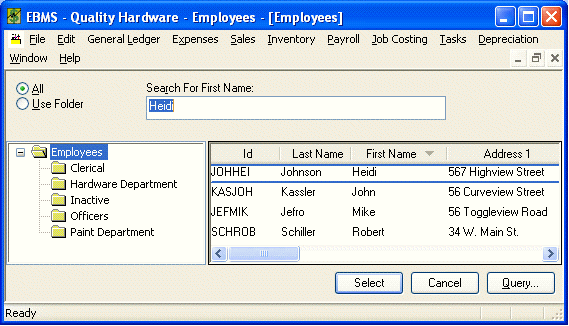
The main employee window is used to record information about each employee such as name, address, and tax information. The employee window is also very useful in viewing history such as timecards and tax history. If you wish to edit or view information for a specific employee, select Employees from the Payroll menu and the Employee list will appear:

If you wish to create a new employee, review the Entering New Employees section. For more details about sorting, searching or changing the list review the EBMS Features > Search Lists section. Select the employee to be edited or viewed and the following screen will open:
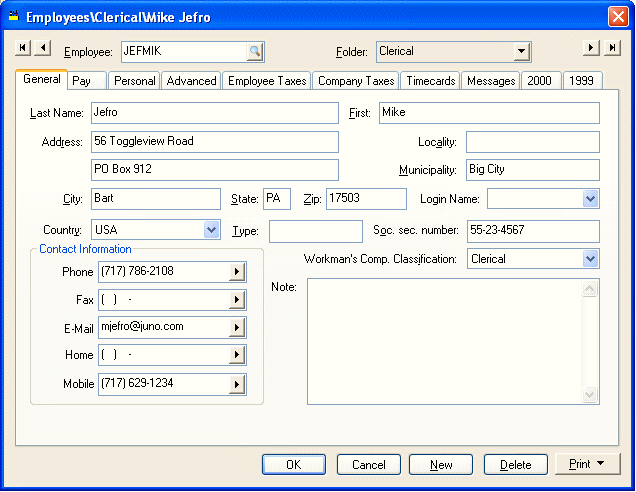
General Tab
· The Employee Id code of the employee that was selected will appear in the upper left-hand corner of the employee window and the employee’s name will appear on the window title. To change the employee’s Id right click on the Employee field with your mouse to open the context menu. Select Change ID, which will start a lengthy process of changing this employee’s code throughout the system. It is possible to load a different employee by clicking on the lookup button to the right of the Employee entry field and selecting a new employee.
· Clicking on the down arrow button to the right of the current folder name and selecting a new folder can change the employee’s Folder. If an employee is placed in the inactive folder, this employee will not be listed on a number of reports.
· The Name, Address, and Contact Information may be changed at any time although the change will not be reflected on existing timecards.
· Type - You can enter an optional employee Type for each employee, which will allow you to print out reports, or query employees in groups.
Example: If you want to group all the employees who work in a specific warehouse – you could enter a type – "South WH" and then query by this entry. The Type field is very useful when employees are part of more than one group. Use the type field if you wish to group a specific employee within two or more different groups. Grouping employees only by using folders is limited since each employee can only appear once in a folder. By entering a group of keywords or group names within the type field separated by a comma or space, the user can then query the employee by any type or combination of types.
· Locality – Enter the county of the employee.
· Enter the Municipality or town in which the employee resides.
· Enter employee’s Social Security number. Social security numbers are required on all employees by law.
· Set the employee’s Workman’s Comp. Classification. Go to Payroll > Options > Workman’s Comp tab to add or edit available classifications and to enter Workman’s Compensation rates. Review the Workman's Compensation section for more details.
· You can use the Note field to enter miscellaneous employee information. The length of this entry field is not limited but will scroll if more information is entered than what can be displayed on a single page.
Pay Tab
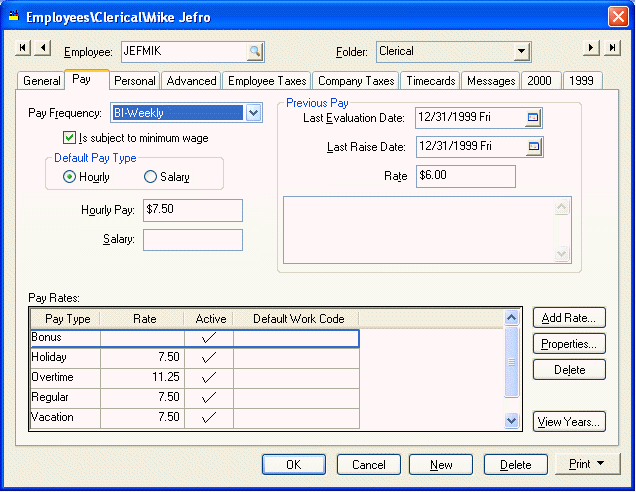
· Enter or change the Hourly pay. This will affect all future timecards only.
· Enter or change the Salary amount. This will affect all future timecards only.
· Pay Frequency should be set to the length of the normal payroll period such as Weekly or BI-Weekly.
· Check the Is subject to minimum wage box if applicable.
· Default Pay Type should be set to the most common pay type, Hourly, or Salary.
To setup the Pay Rates table:
1. To add a rate to the list, click on the Add Rate button. The following dialog should appear:

2. Select the additional Pay Type to be listed for this employee. New pay types must be created in the Pay Types tab within the payroll Options window. Review the Pay Types section for details on how to create new pay types.
3. Enter the default Work Code associated with this pay type. Let the work code field blank if you do not wish to default a work code for this employee. Review the Work Codes section for details on the function of a work code.
4. The Rate Formula is only useful when pay types are Hour based. See Payroll > Options > Pay Types tab to identify Hour and Dollar based pay types. The Rate Formula is calculated from the employee Hourly Pay rate amount. To setup the Rate Formula, perform the following two steps.
a. Select the formula template by clicking on the right arrow and choose one of the available templates.
b. Fill in formula values such as percentages or dollar values.
EXAMPLE
Select Add ___ % formula and enter the formula value of 50 to create formula Add 50 %. This formula would be appropriate for an overtime pay type since the rate would be the pay rate + 50 %, or time and a half.
Select Add $___ formula and enter the formula value of 1 to create formula Add $1. This formula would add $1.00 to the hourly pay rate whenever this pay type is used.
Select Equal to formula whenever the pay rate is equal to the hourly rate. This is the standard formula for regular pay.
5. Increment fields are only used for benefit pay types that are limited such as vacation or sick days. See the Payroll > Options > Pay Types tab to identify the Benefit pay types. If you do not limit this pay type, ignore all Increment field entries.
1. Increment Condition: Choose one of the following options:
· Each Time Card will increment the available benefit hours each time a timecard is processed.
· Beginning of Year will increment once at the beginning of the calendar year. This option will show only if the pay type is configured to include this option. Review the Pay Types section for details.
· Employee’s Anniversary will increment once a year on the anniversary of the Hire date. This option will show only if the pay type is configured to include this option. Review the Pay Types section for details.
· The Never option will not increment the Hours Accumulated amount automatically but will require manual entry of hours accumulated.
6. The Amount field reflects the amount that Hours Accumulated should be incremented every time the Increment Condition is TRUE.
7. Hours Available field reflects the total accumulated hours. Go to total available hours within the pay list. Available hours = Hours Accumulated – Total Hours Used - Click View Years button to view Total Hours used for each year.
8. Click OK to save or Cancel to abort.
· Click the Properties button to edit the Pay Types. Field properties are explained in Add Rate section above.
· Click Delete to remove pay type from the employee’s pay type list. A pay type cannot be deleted if pay history is present.
· Click on the View Years button to view the employee pay history and the following window will open:
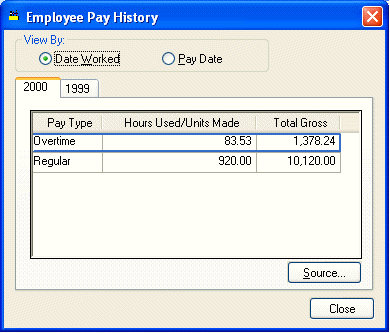
The Employee Pay History window displays the annual total of hours and gross pay for each pay type. To view the details source of totals, double click on the pay type or click on the Source button. Click Close to return to the Pay tab.
Personal Tab
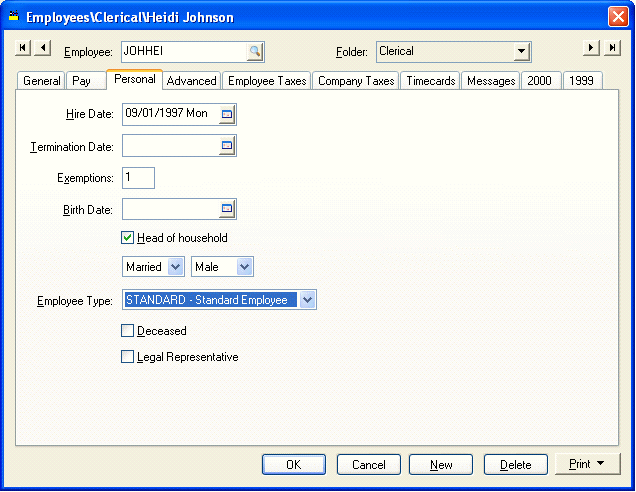
· Hire Date - Enter the date the employee was hired.
NOTE: The employee’s anniversary date used to reset benefit pay settings etc is determined by the hire date. If the anniversary date needs to be different then the hire date because of part time status changes, place the original hire date in the employee note area and change the hire date to the desired anniversary date.
· Enter the Termination Date when the employee is terminated or is no longer employed by the company.
· Enter the number of Exemptions the employee is claiming for tax purposes. The employee is included in the number of exemptions. For example, if an employee were married with one child the employee would normally claim three exemptions. If the employee is single, the standard is one exemption. If this number is changed the following message will appear:

· Click Yes to change exemptions for all taxes. If a different number of exemptions are used for any taxes, go to the Employee Taxes tab and change exemptions to desired amount.
· Enter the employee’s Birth Date.
· If the employee is claiming Head of Household status for tax purposes, click the switch ON.
· Select the employee’s marital status as Single or Married by clicking on down arrow. If the status is changed the following message will appear:

Click Yes to change marital status for all taxes. If a different status is used for any taxes, go to the Employee Taxes tab and change exemptions to desired setting.
· Set the employee’s sex as Male or Female.
· Select the Employee Type for W-2 purposes.
· If the employee is Deceased, or they have Legal Representation, click the appropriate switch. These settings will show on the payroll W-2 form.
Advanced Tab

· Enter the Makeup Pay general ledger account as an expense account to record any makeup pay to be paid to an employee. Review the Minimum Wage and Makeup pay section for more details.
· Set the Payroll Payable general ledger account, which requires an account with a Payroll Payable classification. If no account is available go to General Ledger > Chart of Accounts and add a liability account with a Payroll Payable classification.
· The Credit Workweek Amount is the minimum dollar amount an employee needs to work to become eligible for state benefits such as Workers’ Compensation. This total should be set within the default folder before new employees are added. If this total changes for all employees, filter down the new default amounts to all existing employees. Review the Changing Defaults, Filter Down Data, and Globally Editing data section for more details.
· The employee’s Daily Hours can be entered here on a daily basis and they will be transferred to the timecard when a new timecard is entered. Daily hours record the exact times that the employee worked. The law does not require this time if the employee is paid by the hour or salaried. Review the Daily Hours section for more details on entering and processing Daily Hours. If the employee’s hours are not similar from one payroll to the next, or if this employee does not need to have daily hours recorded, the Daily Hours information entries can be ignored.
For information on the Employee Taxes tab or the Company Taxes tab review the Taxes and Deductions section.
For information on the Timecards tab, review the Employee History section.
· The Messages tab is used to setup messages for individual employees. The message feature can be used to display reminders within the timecard screen. Review the Customer Messages section for more details on creating employee messages.
Click OK to save employee information.